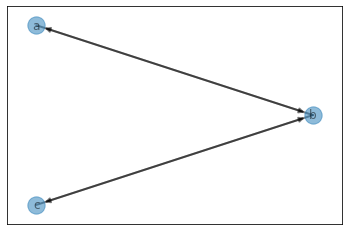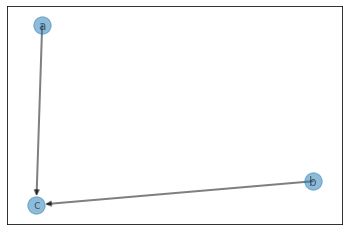1
2
3
4
5
6
7
8
import time, math, sys
from typing import List, Dict
from collections import defaultdict
import networkx as nx
import matplotlib.pyplot as plt
from networkx.drawing.nx_pylab import draw_networkx, draw_networkx_edge_labels, draw_networkx_edges
sys.path.append("/home/swyoo/algorithm/")
from utils.verbose import logging_time, visualize_graph
399. Evaluate Division
DFS
Idea
I saw this document[1] to solve this question.
I cited an example as follows.
For example:
Given:a/b = 2.0, b/c = 3.0
We can build a directed graph:
a -- 2.0 --> b -- 3.0 --> c
If we were asked to finda/c, we have:
a/c = a/b * b/c = 2.0 * 3.0
In the graph, it is the product of costs of edges.
Therefore, follow these steps to solve this problem.
Step1. contruct a graph, where the edge weights are reciprocal.
Step2. using the dfs search, aggregate the edges’ rates from source to target.
1
2
3
4
5
6
7
8
9
10
11
12
13
14
15
16
17
18
19
20
21
22
23
24
25
26
27
28
29
30
31
32
33
34
35
36
37
38
class Solution:
@logging_time
def calcEquation(self, equations: List[List[str]],
values: List[float], queries: List[List[str]],
show=False) -> List[float]:
edges = [] # for visualization
graph = defaultdict(list)
nodes = set()
for (u, v), w in zip(equations, values):
nodes.add(u), nodes.add(v)
if show:
edges.append([v, u, w])
edges.append([u, v, 1/w])
graph[v].append((u, w))
graph[u].append((v, 1/w))
if show:
print("edges info:", edges)
visualize_graph(edges=edges, weighted=True)
seen = set()
def dfs(i, target, loc=1):
seen.add(i)
if i == target:
# print("find res:", 1 / loc)
res.append(1/loc)
return True
for j, w in graph[i]:
if j not in seen and dfs(j, target, loc * w):
return True
return False
res = []
for q in queries:
seen = set()
if q[0] not in nodes or q[1] not in nodes or not dfs(q[0], q[1]):
# if fail to find (q[0]/q[1])
res.append(-1.)
return res
sol = Solution()
1
2
3
4
equations = [["a", "b"], ["b", "c"]]
values = [2.0, 3.0]
queries = [["a", "c"], ["b", "a"], ["a", "e"], ["a", "a"], ["x", "x"]]
sol.calcEquation(equations, values, queries, show=True, verbose=True)
1
2
edges info: [['b', 'a', 2.0], ['a', 'b', 0.5], ['c', 'b', 3.0], ['b', 'c', 0.3333333333333333]]

1
2
WorkingTime[calcEquation]: 158.74386 ms
1
[6.0, 0.5, -1.0, 1.0, -1.0]
Improved DFS
I cited a paragraph from this document[1].
One optimization, which is not implemented in the code, is to “compress” paths for past queries, which will make future searches faster. This is the same idea used in compressing paths in union find set. So after a query is conducted and a result is found, we add two edges for this query if these edges are not already in the graph.
Union Find
Union find approach can be possible.
please refer this document
Note that
- Path compression is possible
- However, union by rank does not possible.
The algorithm is designed in this way.
union(x, y, 0)means findx / y.w = 0determines whether to find an answer of a query or not.
1
2
3
4
5
6
7
8
9
10
11
12
13
14
15
16
17
18
19
20
21
22
23
24
25
26
27
28
29
30
31
32
33
34
35
36
37
38
39
40
from typing import List
from utils.verbose import visualize_ds
class Solution2:
def calcEquation(self, equations: List[List[str]],
values: List[float], queries: List[List[str]],
show=False) -> List[float]:
par = {}
def find(x):
if x not in par:
par[x] = (x, 1)
return par[x]
if x != par[x][0]:
p, pr = find(par[x][0])
par[x] = (p, par[x][1] * pr)
return par[x]
def union(x, y, w):
""" return x / y.
if w is 0, query mode, """
x, xr, y, yr = *find(x), *find(y)
if not w:
return xr / yr if x == y else -1.0
if x != y:
par[x] = (y, yr/xr*w)
for (u, v), w in zip(equations, values):
union(u, v, w)
ans = []
for x, y in queries:
if x not in par or y not in par:
ans.append(-1.0)
else:
ans.append(union(x, y, 0))
if show:
print("show disjoint set as follows")
par = {k: v[0] for k, v in par.items()}
visualize_ds(par)
return ans
sol2 = Solution2()
1
2
3
4
equations = [["a", "b"], ["b", "c"]]
values = [2.0, 3.0]
queries = [["a", "c"], ["b", "a"], ["a", "e"], ["a", "a"], ["x", "x"]]
print(sol2.calcEquation(equations, values, queries, show=True))
1
2
show disjoint set as follows

1
2
[6.0, 0.5, -1.0, 1.0, -1.0]
Referenece
[0] leetcode problem
[1] a document in the discuss category of the problem
[2] another document in the discuss category of the problem


Leave a comment